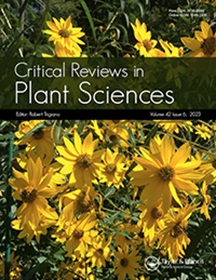友好环境下粗放种植系统真菌病原体管理的新工具
IF 4.9
2区 生物学
Q1 PLANT SCIENCES
引用次数: 0
摘要
作物生产在全球粮食安全中起着至关重要的作用,玉米、小麦、大豆和水稻等关键商品是种植最广泛的作物。这些主要作物主要在粗放种植系统中种植。然而,这些系统受到真菌疾病的威胁,这可能导致产量大幅下降。在世界范围内广泛种植的作物中,管理真菌病原体最广泛采用的策略是化学控制。然而,这种策略有多种缺点和潜在危害,包括病原体耐药性、环境污染以及对人类健康和其他生物体的负面影响。因此,在过去的几十年里,传统的农业系统受到了质疑,向更可持续的生产方法过渡的趋势已经出现。新的生产模式强调采用生态友好的方法进行疾病管理,生物杀菌剂和生物刺激剂是越来越受欢迎的新工具之一。然而,由于缺乏全球统一,在不同国家建立这些工具的监管框架具有挑战性。本综述的主要目的是收集有关新工具和技术(市场上可用或正在研究)的分散信息,这些新工具和技术适用于由最新科学进展产生的广泛种植的作物。此外,本综述旨在澄清这些新工具(生物刺激素、生物杀菌剂、植物防御诱导剂以及基因编辑、RNAi、纳米技术和物理治疗等技术)的分类,以加强对它们的理解,并批判性地评估它们的潜力、挑战和未来前景。此外,审查的目的是确定在园艺或其他集约化生产系统中成功实施但尚未实际应用于广泛种植的作物的工具,为未来的进步和这些工具的潜在适应性铺平道路,以适应广泛的农业实践。最后,本综述提出了一个实用的疾病管理模型,该模型结合了新的工具来解决小麦的一个关键疾病。关键词:广泛种植系统;病害综合治理;新工具;生物刺激素;生物杀菌剂;数据可用性声明数据共享不适用于本文,因为本研究没有创建或分析新的数据。该出版物是阿根廷布宜诺斯艾利斯大学(UBACYT 20020220100114BA)和波兰国家学术机构- NAWA (BPI/PST/2021/1/00034)共同资助的合作工作的一部分。本文章由计算机程序翻译,如有差异,请以英文原文为准。
New Tools for the Management of Fungal Pathogens in Extensive Cropping Systems for Friendly Environments
AbstractCrop production plays a critical role in global food security, with key commodities such as corn, wheat, soybean, and rice ranking among the most widely cultivated crops. These major crops are predominantly grown within extensive cropping systems. However, these systems are threatened by fungal diseases, which may cause substantial yield reductions. The most widely adopted strategy to manage fungal pathogens in extensively grown crops worldwide is chemical control. Nevertheless, this strategy has multiple drawbacks and potential hazards, including pathogen resistance, environmental contamination, and negative effects on human health and other organisms. As a logical result, over the last decades, conventional agricultural systems have been questioned and a transition toward more sustainable production methods has emerged. The new productive paradigm emphasizes the adoption of eco-friendly approaches to disease management, with biofungicides and biostimulants among the new tools gaining popularity. However, establishing a regulatory framework for these tools in different countries has proven challenging due to the lack of global harmonization. The primary objective of this review is to gather dispersed information on new tools and technologies (either available in the market or being studied) applicable to extensively grown crops generated by the latest scientific advances. Additionally, the review seeks to contribute to clarifying the categorization of these new tools (biostimulants, biofungicides, plant defense inducers, and technologies such as gene editing, RNAi, nanotechnology, and physical treatment) to enhance their understanding and to critically assess their potentials, challenges, and future perspectives. Furthermore, the review aims to identify tools successfully implemented in horticulture or other intensive production systems but not yet practically applied in extensively grown crops, to pave the way for future advances and potential adaptations of these tools to suit extensive agricultural practices. Finally, this review presents a practical disease management model that incorporates new tools to address a key disease in wheat.Keywords: Extensive cropping systemsintegrated disease managementnew toolsbiostimulantsbiofungicidesplant resistance inducersdual-effect tools Disclosure statementThe authors declare no conflict of interest.Data availability statementData sharing is not applicable to this article as no new data were created or analyzed in this study.Additional informationFundingThe publication was part of a collaborative work co-financed by the University of Buenos Aires (UBACYT 20020220100114BA), Argentina, and the Polish National Agency for Academic - NAWA (BPI/PST/2021/1/00034).
求助全文
通过发布文献求助,成功后即可免费获取论文全文。
去求助
来源期刊
CiteScore
12.90
自引率
1.40%
发文量
15
审稿时长
>12 weeks
期刊介绍:
Critical Reviews in Plant Sciences focuses on presenting in-depth and up-to-date reviews of timely and/or cutting-edge subjects in the broad discipline of plant science, ranging from molecular biology/biochemistry through the areas of cell biology, plant pathology and physiology, genetics, classical botany, and ecology, to practical agricultural applications. Articles in the journal provide an up-to-date literature base for researchers and students, pointing the way towards future research needs. The journal is also a significant source of credible, objective information to aid decision makers at all levels.

 求助内容:
求助内容: 应助结果提醒方式:
应助结果提醒方式:


